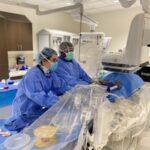.jpg) The Florida population explosion in the 1970s and 1980s of full-time residency led to the creation of those support services necessary to service the public. Hospitals and medical facilities were constructed throughout the state.
The Florida population explosion in the 1970s and 1980s of full-time residency led to the creation of those support services necessary to service the public. Hospitals and medical facilities were constructed throughout the state.
These buildings are now 40 and 50 years old; partially modernized over the years along with the cosmetic facelift and still functioning. The critical question many hospital owners face today is “Do we renovate or is it time for a new facility?”
Regardless of the location or the owner, the question is still the same.
• Over half the technology that is used on a daily basis did not exist when the building was constructed. Technology requires coordination with building infrastructure.
• Evidence-based design provided documentation regarding safe design standards for patient care.
• Building code and AHCA updates have mandated new patient requirements, ventilation standards, stronger buildings and new flood criteria, all of which serve to identify existing vulnerabilities.
• Patient-centric design, family-focused design and the therapeutic benefits of nature are new hospital design concepts which change the patient experience.
• Most significantly, the recent requirement of single-patient rooms mandates the analyses of our buildings regarding usage and the requirements for efficient nursing units.
The list can go on, but you clearly get the point.
To answer the original question with a casual “it depends,” is an oversimplification. The decision to renovate or build new is not an architectural design decision.
Identify your culture, develop your organization and plan your process before designing your buildings. Architects and hospital staff need to be open to a process where planning groups are not immediately led by design professionals, but by staff and facilitators where the designers sit and listen to grasp the big picture. Generating information, technical evaluations and scientific data will lead to better designs. There is an expectation of change in the patient experience. New designs, family spaces and new technology will not only increase patient satisfaction and staff retention, it will lead to better outcomes and shorter hospital stays.
The values and goals described above can be achieved in existing buildings. There might not be two- or three-story tall lobbies, but the desired experiential and sequential activities can occur.
The floor plan of the existing facility must be reasonable. A 16 semi-private floor plate from the 1960s might leave you with no place to turn. But a 36 semi-private room floor plate that eventually is designed into 30 single-patient rooms along with the missing workspaces, storage and well-designed amenities would represent a viable renovation project.
Tight hospital sites might or might not have adequate area for an addition. The addition to a hospital campus is not the simple act of placing a building where one does not exist. It is critical to understand the relationship of medical services, support services, excessive distances and family access, to confirm a viable solution that works appropriately. Technology, healthcare changes and spatial relationships incorporated into the design process will represent the best designs of the future. A beautifully designed building, based upon an incorrect or inefficient premise is a consequence the hospital owners will live with for the rest of their lives.
To renovate or rebuild will be a question of consequence which will be discussed in many upcoming planning sessions. The answer to the question will be determined by what it will take to have a process that works.


























